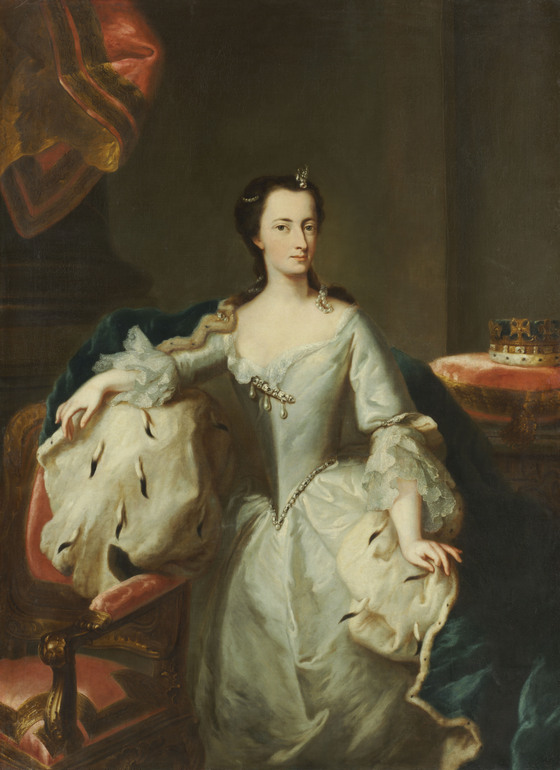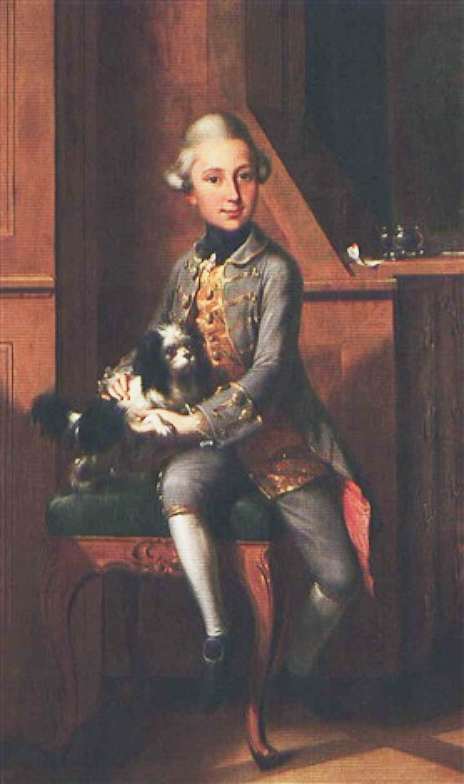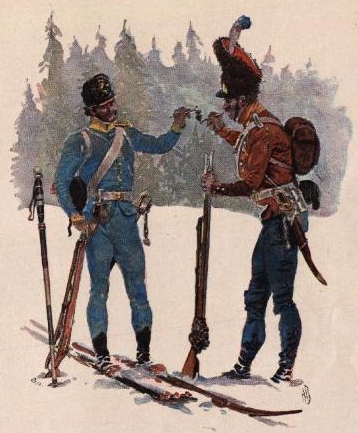|
Prince Charles Of Hesse-Kassel
Prince Charles of Hesse-Kassel (, German and ; 19 December 1744 – 17 August 1836) was a cadet member of the house of Hesse-Kassel and a Danish general field marshal. Brought up with relatives at the Danish court, he spent most of his life in Denmark, serving as royal governor of the twin duchies of Schleswig-Holstein from 1769 to 1836 and commander-in-chief of the Norwegian army from 1772 to 1814. Early life Charles was born in Kassel on 19 December 1744 as the second surviving son of Hesse-Kassel's then hereditary prince, the future Frederick II, Landgrave of Hesse-Kassel and his first wife Princess Mary of Great Britain. His mother was a daughter of King George II of Great Britain and Princess Caroline of Brandenburg-Ansbach and a sister of Queen Louise of Denmark. His father, the future landgrave (who reigned from 1760 and died in 1785), left the family in 1747 and converted to Catholicism in 1749. In 1755 he formally ended the marriage with Mary. The grandfather, Wil ... [...More Info...] [...Related Items...] OR: [Wikipedia] [Google] [Baidu] |
Order Of The Elephant
The Order of the Elephant ( da, Elefantordenen) is a Danish order of chivalry and is Denmark's highest-ranked honour. It has origins in the 15th century, but has officially existed since 1693, and since the establishment of constitutional monarchy in 1849, is now almost exclusively used to honour royalty and heads of state. History A Danish religious confraternity called the Fellowship of the Mother of God, limited to about fifty members of the Danish aristocracy, was founded during the reign of Christian I during the 15th century. The badge of the confraternity showed the Virgin Mary holding her Son within a crescent moon and surrounded with the rays of the sun, and was hung from a collar of links in the form of elephants much like the present collar of the Order. After the Reformation in 1536 the confraternity died out, but a badge in the form of an elephant with his profile on its right side was still awarded by Frederick II. This latter badge may have been inspire ... [...More Info...] [...Related Items...] OR: [Wikipedia] [Google] [Baidu] |
Field Marshal
Field marshal (or field-marshal, abbreviated as FM) is the most senior military rank, ordinarily senior to the general officer ranks. Usually, it is the highest rank in an army and as such few persons are appointed to it. It is considered as a five-star rank (OF-10) in modern-day armed forces in many countries. Promotion to the rank of field marshal in many countries historically required extraordinary military achievement by a general (a wartime victory). However, the rank has also been used as a divisional command rank and also as a brigade command rank. Examples of the different uses of the rank include Austria-Hungary, Pakistan, Prussia/Germany, India and Sri Lanka for an extraordinary achievement; Spain and Mexico for a divisional command ( es, link=no, mariscal de campo); and France, Portugal and Brazil for a brigade command (french: link=no, maréchal de camp, pt, marechal de campo). Origins The origin of the term dates to the early Middle Ages, originally meaning t ... [...More Info...] [...Related Items...] OR: [Wikipedia] [Google] [Baidu] |
William I, Elector Of Hesse
William I, Elector of Hesse (german: link=no, Wilhelm I., Kurfürst von Hessen; 3 June 1743 – 27 February 1821) was the eldest surviving son of Frederick II, Landgrave of Hesse-Kassel (or Hesse-Cassel) and Princess Mary of Great Britain, the daughter of George II. Biography Early life Prince William was born on 3 June 1743 in Kassel, capital of the Landgraviate of Hesse-Kassel in the Holy Roman Empire. Born into the House of Hesse, he was the second but eldest surviving son of Prince Frederick of Hesse-Kassel (the future Landgrave Frederick II), and his wife Princess Mary of Great Britain. A former heir to the landgraviate, also named William, had died in infancy in 1742; therefore, hopes were high for the future of the new heir apparent. He had two younger brothers: Prince Charles and Prince Frederick. His father's marriage with the British princess was not a happy one, and Frederick abandoned the family in 1747 and converted to Catholicism in 1749. In 1755 he formally a ... [...More Info...] [...Related Items...] OR: [Wikipedia] [Google] [Baidu] |
County Of Hanau
The County of Hanau was a territory within the Holy Roman Empire, evolved out of the Lordship of Hanau in 1429. From 1456 to 1642 and from 1685 to 1712 it was divided into the County of Hanau-Münzenberg and the County of Hanau-Lichtenberg. After both lines became extinct the ''County of Hanau-Münzenberg'' was inherited by the Landgraviate of Hesse-Kassel, the ''County of Hanau-Lichtenberg'' by the Landgraviate of Hesse-Darmstadt in 1736. Creation In 1429 Emperor Sigismund of the Holy Roman Empire declared Reinhard II. of Hanau a count, so his possessions, the Lordship (''Herrschaft'') of Hanau, became the ''County of Hanau''. The main part of it was positioned to the north of the river Main stretching from the East of Frankfurt am Main eastwards through the valley of the river Kinzig to Schlüchtern and into the Spessart mountains to Partenstein. Legally not correct the title ''County of Hanau'' is used in later literature sometimes also for its territorial pred ... [...More Info...] [...Related Items...] OR: [Wikipedia] [Google] [Baidu] |
William VIII, Landgrave Of Hesse-Kassel
William VIII (10 March 1682 – 1 February 1760) ruled the German Landgraviate Hesse-Kassel from 1730 until his death, first as regent (1730–1751) and then as landgrave (1751–1760). Life Born in Kassel, he was the seventh son of Charles I, Landgrave of Hesse-Kassel and Maria Amalia of Courland. After his elder brother Frederick became King of Sweden in 1720 and his father died in 1730, he became de facto ruler of Hesse-Kassel. He officially became landgrave after his brother's death on 25 March 1751. Five years later, the Seven Years' War began and William joined with the Prussian and British forces. Hesse-Kassel became an important battlefield and was occupied by France on several occasions. He had a deep, personal friendship with Frederick the Great, King of Prussia, and Holy Roman Emperor Charles VII. His second son and successor, Frederick, became a Catholic, which led to restrictions on Catholicism in the Calvinist landgraviate and the transfer of the Principality o ... [...More Info...] [...Related Items...] OR: [Wikipedia] [Google] [Baidu] |
Catholicism
The Catholic Church, also known as the Roman Catholic Church, is the largest Christian church, with 1.3 billion baptized Catholics worldwide . It is among the world's oldest and largest international institutions, and has played a prominent role in the history and development of Western civilization.O'Collins, p. v (preface). The church consists of 24 ''sui iuris'' churches, including the Latin Church and 23 Eastern Catholic Churches, which comprise almost 3,500 dioceses and eparchies located around the world. The pope, who is the bishop of Rome, is the chief pastor of the church. The bishopric of Rome, known as the Holy See, is the central governing authority of the church. The administrative body of the Holy See, the Roman Curia, has its principal offices in Vatican City, a small enclave of the Italian city of Rome, of which the pope is head of state. The core beliefs of Catholicism are found in the Nicene Creed. The Catholic Church teaches that it is th ... [...More Info...] [...Related Items...] OR: [Wikipedia] [Google] [Baidu] |
Louise Of Great Britain
Louise of Great Britain (originally Louisa; 1724 – 19 December 1751) was Queen of Denmark and Norway from 1746 until her death, as the first wife of King Frederick V. She was the youngest surviving daughter of King George II of Great Britain and Caroline of Ansbach. The marriage between Louise and Frederick V of Denmark was arranged solely for political reasons (King George's ministers wanted Danish support in disputes with Prussia). Although the marriage was arranged, the couple got along quite well, at least during the first years of marriage. Louisa, who encouraged performances by actors and musicians, was a popular figure at the Danish court even though she never exerted significant influence over her husband's decision-making. Early years Princess Louise was born as the fifth daughter and youngest child of the then Prince and Princess of Wales, on 1724, at Leicester House, Westminster, London. She was born ten years after her paternal grandfather, Elector George Lo ... [...More Info...] [...Related Items...] OR: [Wikipedia] [Google] [Baidu] |
Caroline Of Brandenburg-Ansbach
, father = John Frederick, Margrave of Brandenburg-Ansbach , mother = Princess Eleonore Erdmuthe of Saxe-Eisenach , birth_date = , birth_place = Ansbach, Principality of Ansbach, Holy Roman Empire , death_date = , death_place = St James's Palace, London, Great Britain , burial_date = 17 December 1737 , burial_place = Westminster Abbey, London Caroline of Brandenburg-Ansbach (Wilhelmina Charlotte Caroline; 1 March 1683 – 20 November 1737) was Queen of Great Britain and Ireland and Electress of Hanover from 11 June 1727 until her death in 1737 as the wife of King George II. Caroline's father, Margrave John Frederick of Brandenburg-Ansbach, belonged to a branch of the House of Hohenzollern and was the ruler of a small German state, the Principality of Ansbach. Caroline was orphaned at a young age and moved to the enlightened court of her guardians, King Frederick I and Queen Sophia Charlotte of Prussia. At the Prussian court, her previously limited education was wide ... [...More Info...] [...Related Items...] OR: [Wikipedia] [Google] [Baidu] |
George II Of Great Britain
, house = Hanover , religion = Protestant , father = George I of Great Britain , mother = Sophia Dorothea of Celle , birth_date = 30 October / 9 November 1683 , birth_place = Herrenhausen Palace,Cannon. or Leine Palace, Hanover , death_date = , death_place = Kensington Palace, London, England , burial_date = 11 November 1760 , burial_place = Westminster Abbey, London , signature = Firma del Rey George II.svg , signature_alt = George's signature in cursive George II (George Augustus; german: link=no, Georg August; 30 October / 9 November 1683 – 25 October 1760) was King of Great Britain and Ireland, Duke of Brunswick-Lüneburg (Hanover) and a prince-elector of the Holy Roman Empire from 11 June 1727 ( O.S.) until his death in 1760. Born and brought up in northern Germany, George is the most recent British monarch born outside Great Britain. The Act of Settlement 1701 and the Acts of Union 1707 positioned his grandmother, So ... [...More Info...] [...Related Items...] OR: [Wikipedia] [Google] [Baidu] |
Landgraviate Of Hessen-Kassel
The Landgraviate of Hesse-Kassel (german: Landgrafschaft Hessen-Kassel), spelled Hesse-Cassel during its entire existence, was a state in the Holy Roman Empire that was directly subject to the Emperor. The state was created in 1567 when the Landgraviate of Hesse was divided upon the death of Philip I, Landgrave of Hesse. His eldest son William IV inherited the northern half of the Landgraviate and the capital of Kassel. The other sons received the Landgraviate of Hesse-Marburg, the Landgraviate of Hesse-Rheinfels and the Landgraviate of Hesse-Darmstadt. During the Napoleonic reorganisation of the Empire in 1803, the Landgrave of Hesse-Kassel was elevated to an Electorate and Landgrave William IX became an Imperial Elector. Many members of the Hesse-Kassel House served in the Danish military gaining high ranks and power in the Oldenburg realm due to the fact that many Landgraves were married to Danish princesses. Members of the family who are known to have served Denmark-Norwa ... [...More Info...] [...Related Items...] OR: [Wikipedia] [Google] [Baidu] |
Norwegian Army
The Norwegian Army ( no, Hæren) is the land warfare service branch of the Norwegian Armed Forces. The Army is the oldest of the Norwegian service branches, established as a modern military organization under the command of the King of Norway in 1628. The Army participated in various continental wars during the 17th, 18th, and 19th centuries as well, both in Norway and abroad, especially in World War II (1939–1945). It constitutes part of the Norwegian military contribution as a charter member of the North Atlantic Treaty Organization (NATO) since 1949. History Creation of the Norwegian Army After the Kalmar War broke out in 1611, the Danish-Norwegian king, Christian IV tried to revive the leidang, with dire results. As the Norwegian peasantry had not been armed or trained in the use of arms for nearly three centuries, they were not able to fight. Soldiers deserted or were captured. The soldiers had to participate in military drills, while providing supplementary labor ... [...More Info...] [...Related Items...] OR: [Wikipedia] [Google] [Baidu] |



.jpg)


_und_ihre_Kinder_Georg_August_und_Sophie_Dorothea.jpg)
